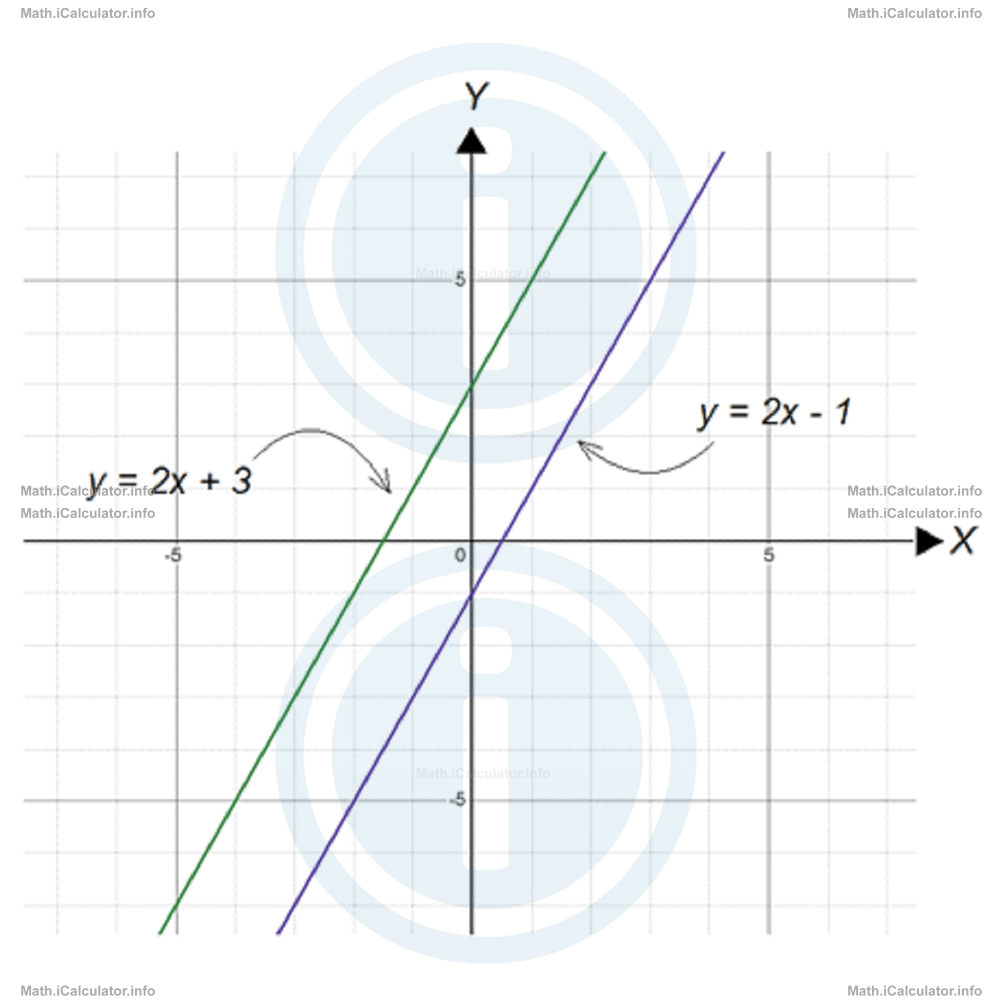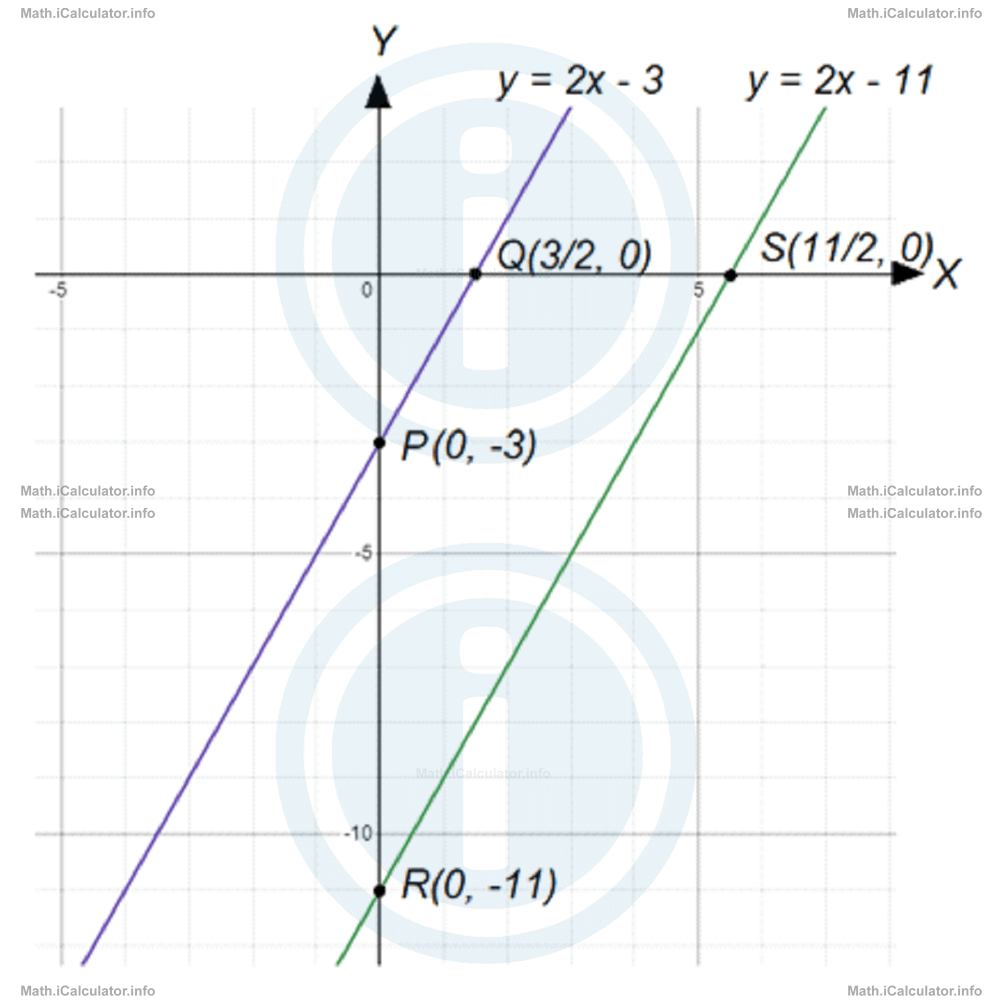Menu
Math Lesson 14.4.2 - What is the Condition for Two (or more) Lines to be Parallel?
Please provide a rating, it takes seconds and helps us to keep this resource free for all to use
Welcome to our Math lesson on What is the Condition for Two (or more) Lines to be Parallel? , this is the second lesson of our suite of math lessons covering the topic of Parallel, Perpendicular and Intersecting Graphs, you can find links to the other lessons within this tutorial and access additional Math learning resources below this lesson.
What is the Condition for Two (or more) Lines to be Parallel?
In the previous two tutorials (14.2 Slopes and Gradients and 14.3 Equations of Linear Graphs), we explained the concept of gradient, which is a mathematical representation of the steepness of a linear graph. Given this, it is evident that two parallel lines have the same steepness, and therefore, the same gradient m.
On the other hand, since the graphs do not pass through the same coordinates, they have a different y-intercept. This means the constant n of their corresponding equations is different. Otherwise, the lines would not be parallel but convergent.
From the above reasoning, we conclude that the equations of two parallel lines L1 and L2 are:
For L1:
and for L2:
For example, the lines
and
are parallel, as the gradient is equal in both lines (m = 2) but the constant n is different (in the first line, n = -1 and in the second line, n = 3). The following figure shows both lines in the same graph.

Example 1
Find the equation of the line L1 with equation y = mx + n if it is parallel to the other line L2 with equation y = -2x + 3 if the first line L1 passes through the point A(1, -2).
Solution 1
Since L1 and L2 are parallel, they have the same gradient (m = -2). Therefore, the equation of L1 is
We have another clue given; point A(1, -2), which belongs to L1. This means we can substitute x = 1 and y = -2 in the above relation to find the complete equation of L1. We have>/p>
-2 = -2 + n
n = 0
Therefore, the equation of the line L1 is
or simply,
We can find many more things about parallel lines besides the equations and/or orientation. Let's consider another example.
Example 2
The distance between the x-intercepts of the parallel lines L1 and L2 is 4 units (L2 is more on the right). The equation of L1 is
and that of L2 is
- Calculate the value of the gradient m for the line L1.
- Calculate the value of the constant n for the line L2.
- Calculate the distance between the corresponding y-intercepts.
- Plot the two graphs in the same coordinates system.
Solution 2
- Since L1 and L2 are parallel, they have the same gradient. Thus for the first line, we obtain the value of gradient m = 2. In this way, the equation of the first line L1 is y = 2x - 3
- The x-intercept of L1 is obtained by substituting y = 0 in the first equation. Thus, we have 0 = 2x - 3Given that the x-intercept of L2 is 4 units on the right of that of L1, we have for the x-intercept of L2:
2x = 3
xint (L1) = 3/2xint (L2) = 3/2 + 4This means the point Q(11/2, 0) is a point of the second line L2. Substituting these coordinates in the equation of L2
= 3/2 + 8/2
= 11/2y = 2x + nto obtain the value of the constant n, i.e.0 = 2 ∙ 11/2 + nThis means that line L2 has the equation
0 = 11 + n
n = -11y = 2x - 11 - Since the y-intercept of a line has the value of the constant n, and given that the constants of the two lines L1 and L2 are -3 and -11 respectively, the distance between the two t-intercepts is 8 units because yint (L2) - yint (L1)The negative sign means that L2 is below L1.
= -11 - (-3)
= -8 - We already know all intercepts with the axes. Thus, for the line L1 we already know two points: Q(3/2, 0), which is the x-intercept and P(0, -3), which is the y-intercept, while for L2 we have two other points given: S(11/2, 0), which is the x-intercept and R(0, -11), which is the y-intercept. Therefore, we plot the graphs based on these four points, as shown in the figure below.
 It is easy to see that the two lines are parallel, as expected.
It is easy to see that the two lines are parallel, as expected.
More Parallel, Perpendicular and Intersecting Graphs Lessons and Learning Resources
Whats next?
Enjoy the "What is the Condition for Two (or more) Lines to be Parallel? " math lesson? People who liked the "Parallel, Perpendicular and Intersecting Graphs lesson found the following resources useful:
- Condition Feedback. Helps other - Leave a rating for this condition (see below)
- Linear Graphs Math tutorial: Parallel, Perpendicular and Intersecting Graphs. Read the Parallel, Perpendicular and Intersecting Graphs math tutorial and build your math knowledge of Linear Graphs
- Linear Graphs Revision Notes: Parallel, Perpendicular and Intersecting Graphs. Print the notes so you can revise the key points covered in the math tutorial for Parallel, Perpendicular and Intersecting Graphs
- Linear Graphs Practice Questions: Parallel, Perpendicular and Intersecting Graphs. Test and improve your knowledge of Parallel, Perpendicular and Intersecting Graphs with example questins and answers
- Check your calculations for Linear Graphs questions with our excellent Linear Graphs calculators which contain full equations and calculations clearly displayed line by line. See the Linear Graphs Calculators by iCalculator™ below.
- Continuing learning linear graphs - read our next math tutorial: Line Segments
Help others Learning Math just like you
Please provide a rating, it takes seconds and helps us to keep this resource free for all to use
We hope you found this Math tutorial "Parallel, Perpendicular and Intersecting Graphs" useful. If you did it would be great if you could spare the time to rate this math tutorial (simply click on the number of stars that match your assessment of this math learning aide) and/or share on social media, this helps us identify popular tutorials and calculators and expand our free learning resources to support our users around the world have free access to expand their knowledge of math and other disciplines.